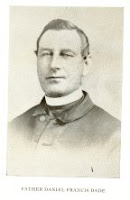You might remember that a few weeks ago I posted on “Dr. Invigaro’s Prescriptive Solemnity” remedy for liturgical situations and choirs. The good doctor contacted me recently with a few comments and questions he’s since received, and a particular one caught my eye.
“Dear Doc Invigaro,
A significant number of my singers in our choir are converts, some who swam the Tiber before we entered the desert, and many over the intervening 40 years. I have noticed as we have deliberately, slowly, “prescriptively” moved towards propers, chant and polyphony that not a few of my singers apparently miss those occasions that the odd spiritual, the rousing gospel tune, the ubiquitous non-catholic anthem or choral song would be programmed. A few have even remarked that we’ve gone all polyphony, all the time. They didn’t seem to be complimenting my programming. Doc, what do I do?”
Dr. Invigaro then left a few suggestions in his memo:
*Eclecticism in programming is neither friend nor foe. It is a tool among others. For example, in my previous advice I reminded folks that if there are folks (among them even clerics) who just can’t abide the imposition of an Offertorio proper into the mix, and thus displacing the notion of the “hymn of the day” which bridges the scripture readings and homily into the Liturgy of the Word…. a well-thought out choral song could present a golden opportunity. For example, in this devotional month of October, or with the upcoming feasts of the Immaculate Conception and Our Lady of Guadalupe, the late Leon Robert’s “CANTICLE OF MARY” could be the pill that fills the bill. It includes congregation, has a solid gravitas to both refrain and melody that could contrast well with other Marian literature. One doesn’t know if it’s incongruous, jarring or uncomplimentary until one tries. This might also work with many other choral and congregational pieces of recent times. John Foley’s “MAY WE PRAISE YOU” or the Mark Haye’s “PRAYER OF ST. FRANCIS” comes to mind.
*In larger parishes where the whole “process” of distributing Holy Communion requires a disproportionately longer time period, one of these eclectic selections could follow the Communio and the Communion Processional, and still allow for reflective silence from all after the Tabernacle Veil is shut. I think of pieces by Lazlo Halmos, such as his proper “CANTATE DOMINO,” that wouldn’t function quite as well if it was programmed at its proper location. Or Stainer’s “GOD SO LOVED THE WORLD,” Brahm’s “HOW LOVELY…” or even a setting of “I HEAR MUSIC IN THE AIR” such as arranged by Alice Parker or John Bell.(Consider editing the text of this one.)
*Of course, if there is a “whipping post” for the odd favorite, it will always remain the terra incognita of the recessional. If you absolutely, positively must “throw a bone” to choir malcontents with pieces like “EVERYTIME I FEEL THE SPIRIT,” or “RIDE ON, KING JESUS,” or Wilhousky’s BATTLE HYMN OF THE REPUBLIC, then this is that time.
One could bridge the time it takes for the celebrant to have made his procession and retreat by a brief organ postlude, and then launch the sonic rockets.
But, these choices cannot be made willy-nilly. As I said, this eclecticism is a tool. Using a specific wrench as a hammer will be injurious, probably to the choir director, the choir, the congregation and worst of all, the integrity of the Liturgy. But if used with precision, might be another tonic to keep your choir members unified and happy.
Sincerely, Dr. Lucious Invigaro”
Well, I don’t know if this addedum protocol might work for you in your program, but I might just consider this as I continue reconfiguring my own bricks. I expect lots of different mileage variances and stalling might result here, there and everywhere.


